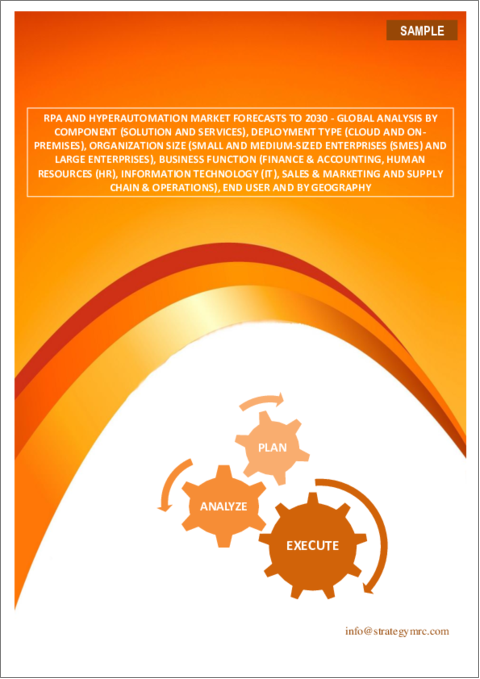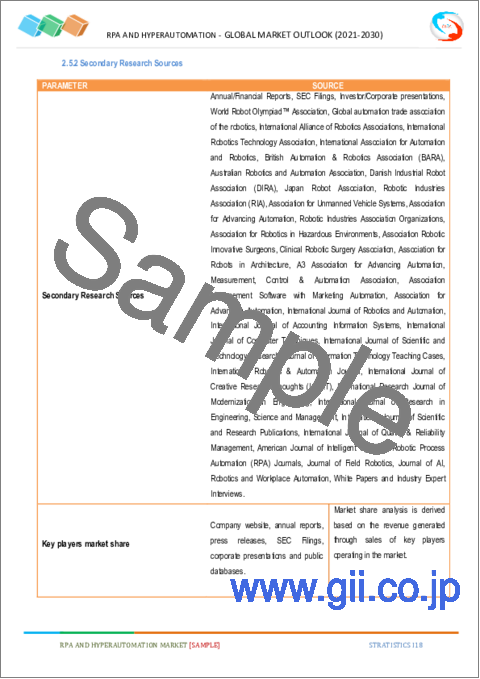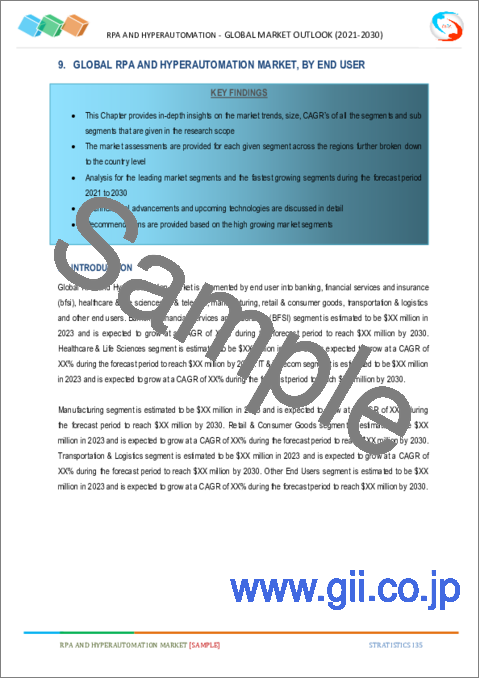|
|
市場調査レポート
商品コード
1308688
RPAおよびハイパーオートメーション市場の2030年までの予測- コンポーネント別、展開タイプ別、組織規模別、ビジネス機能別、エンドユーザー別、地域別の世界分析RPA and Hyperautomation Market Forecasts to 2030 - Global Analysis By Component, Deployment Type, Organization Size, Business Function, End User and By Geography |
||||||
カスタマイズ可能
|
|||||||
| RPAおよびハイパーオートメーション市場の2030年までの予測- コンポーネント別、展開タイプ別、組織規模別、ビジネス機能別、エンドユーザー別、地域別の世界分析 |
|
出版日: 2023年07月01日
発行: Stratistics Market Research Consulting
ページ情報: 英文 175+ Pages
納期: 2~3営業日
|
- 全表示
- 概要
- 図表
- 目次
Stratistics MRCによると、世界のRPAおよびハイパーオートメーション市場は、2023年に120億5,000万米ドルを占め、予測期間中のCAGRは21.4%で成長し、2030年には468億5,000万米ドルに達すると予測されています。
RPAおよびハイパーオートメーションと呼ばれるデジタルトランスフォーメーション戦略では、可能な限り多くのビジネスプロセスを自動化する一方で、人間の入力が必要なものはデジタル的に強化します。機械学習、ロボティックプロセスオートメーション(RPA)、人工知能などの最先端技術を活用します。ハイパーオートメーションは、通常人間が処理する仮想タスクをロボットが実行することを可能にします。自動化技術の進歩に伴い、より一般的になりつつあります。
世界のロボット産業を促進、強化、保護する非営利団体である国際ロボット連盟(IFR)が発表した報告書によると、現在、世界のさまざまな産業で合計300万台の産業用ロボットが使用されており、2020年と比較して10%の増加を示しています。
市場力学:
促進要因
銀行業界の自動化の急速な進展
銀行は、自動化によって、多くの労力と時間を必要とする幅広い業務をこなすことができます。また、銀行業務の自動化により、人的要因によるエラーが大幅に減少します。極めて効率的な取引は顧客満足度を向上させ、多くのプロセスを合理化します。自動化の支援により、銀行員は面倒な反復作業から解放され、より生産的に働き、他の重要な業務に集中することができます。リアルタイムで顧客と対話し、ロボットの大きな利点を活用することで、ロボティックプロセスオートメーションは銀行や金融機関の生産性向上にも役立っています。これが市場拡大を後押しする重要な要素のひとつです。
抑制要因:
企業会計の問題や規制上の制約
デジタル労働力を統合した後、大企業はしばしば、その目的が組織の制約や重要な業務知識とは相反することに気づく。自動化されたビジネス・プロセスを本番稼動から外し、再分析し、タッチポイントやコントロール、意思決定の変更に関連している場合は、再実行する前にアップデートする必要があります。このプロセス全体には多くの時間とリソースがかかります。企業の目標とビジネス・プロセスを一致させるには、熟練した有能な労働力が必要だが、そのような労働力はまだ不足しています。
機会
自動化技術の進歩
自動化プロセスの技術動向は、RPAおよびハイパーオートメーション市場の大きなトレンドとなっています。企業はハイパーオートメーションの助けを借りて安全違反を発見し、事故や法的責任を防ぐことができます。市場ポジションを強化するため、オートメーション業界の大手企業は、ハイパーオートメーションの統一プラットフォームなど、オートメーションにおける最新技術ソリューションの構築に注力しています。
脅威
RPAおよびハイパーオートメーションソリューションに関する認識不足
ロボティックプロセスオートメーション(RPA)とハイパーオートメーション市場の成長は、これらの技術に関する知識不足によって阻害される可能性があります。RPAおよびハイパーオートメーションは、手作業からバーチャル作業員へのビジネスプロセス管理の変化に集中する2つの異なるアイデアです。中小企業を含む多くの業界にとって斬新なアイデアは、ビジネスプロセスを標準化するために使用されるロボットソフトウェアです。さらに、RPAおよびハイパーオートメーション市場の導入は、認知度が低いため、価格に敏感な地域では低いです。これらの要素は成長を阻害すると予測されます。
COVID-19の影響:
COVID-19の大流行により、世界の人的労働力が封鎖され、金融機関は業務を継続するためにRPAの利用を余儀なくされたため、現在、銀行業界ではRPAおよびハイパーオートメーションに対する需要が高まっています。売掛金など特定のプロセスに対する業務量の圧力が極端に変化したことと、リモートワークによってもたらされた遅延は、COVID-19の間に金融機関が直面した2つの大きな困難だっています。そのため、金融機関はRPAやハイパーオートメーションへの投資を増やしています。RPAやハイパーオートメーションは、手作業プロセスの負担を取り除き、労働力を付加価値の高い仕事に再配置し、迅速な回復に備えることを可能にします。その結果、銀行業界におけるRPAおよびハイパーオートメーションは、COVID-19パンデミックによってプラスの影響を受けた。
予測期間中、銀行・金融サービス・保険(BFSI)セグメントが最大になると予想される:
予測期間中、BFSI分野の市場規模が最大になると予測されます。BFSI分野では、様々なシステムが互いにインターフェースされ、取引関連データの転送を可能にしています。トランザクションを円滑に実行し、ワークフローのボトルネックを解消するために、自動化ソリューションはこれらのインターフェイスを制御・監視します。様々なシステムから情報を収集し、詳細な分析ができるように検証チェックを行うことで、これらのソリューションは様々なプロセスの精度と効率を高め、規制やコンプライアンスの報告をサポートします。生産性を高め、コストを削減し、顧客満足度を向上させるため、大半の銀行がハイパーオートメーション・ソリューションの導入を進めており、これが市場の成長を後押ししています。
予測期間中、CAGRが最も高くなると予想されるのはクラウドセグメントである:
クラウドセグメントは、予測期間中に大きなCAGRで成長すると予想されます。クラウドには、コストの削減、ハードウェアを保守するスタッフの不要、より迅速で効率的な成果、OPEXとCAPEXの削減につながる広範な柔軟性と拡張性など、多くの利点があるため、企業はクラウドベースのプラットフォームを利用するようになっています。
最大のシェアを占める地域:
予測期間中、北米は世界のRPAおよびハイパーオートメーション市場に大きく貢献すると予想されます。同地域の企業は新技術をいち早く採用しているため、北米の産業分野の大半はすでにデジタル変革が進んでいます。新技術の迅速な導入により、北米の企業は膨大な量のデータを生成しており、そのようなデータを維持・管理するためのRPAおよびハイパーオートメーション・ソフトウェアの利用に有利な機会を生み出しています。これらすべての要因から、同地域での市場の成長が見込まれています。
CAGRが最も高い地域:
予測期間中、アジア太平洋地域が最も高いCAGRで成長すると予測されます。APACのRPAおよびハイパーオートメーション市場は、主に中国、日本、インドが牽引しています。この地域では、政府の規制やコンプライアンスに対する意識が高まった結果、中小企業や大企業がRPAおよびハイパーオートメーション・ソリューションを積極的に採用し始めています。また、アジア太平洋地域のRPAおよびハイパーオートメーション市場は、同地域の急速な経済開拓、世界化、デジタル化、クラウドベースの技術採用の増加により成長が見込まれています。
主な発展
2023年6月、世界・ハイブリッドクラウドとAI、コンサルティングの専門知識を提供する大手プロバイダーの1つであるIBMは、Apptio Inc.を46億米ドルで買収すると発表しました。この買収により、IBMのIT自動化機能の進化が加速し、企業のリーダーはテクノロジー投資全体で強化されたビジネス価値を提供できるようになると期待されます。
2023年6月、三菱電機株式会社は、ショットキーバリアダイオード(SBD)を組み込んだ新構造の炭化ケイ素金属酸化膜半導体電界効果トランジスタ(SiC-MOSFET)1を開発し、鉄道や直流電源システムなどの大型産業機器向けの3.3kVフルSiCパワーモジュール「FMF800 DC-66 BEW2」に搭載したと発表しました。
2023年6月、テクノロジーサービスとコンサルティングの大手企業であるウィプロ・リミテッドは、マイクロソフトのクラウド上に構築された統合デジタルソリューションの新しいスイートを特徴とする、エネルギーと公益事業向けのウィプロインダストリーイノベーションエクスペリエンスの立ち上げを発表しました。Innovation Experienceは、Microsoft Cloudの機能とWipro FullStride Cloudを統合し、エネルギーおよび公益事業会社が強力かつ戦略的で持続可能な成長を推進するのに役立つ新しいソリューションを推進することを目的としています。
本レポートの内容
- 地域および国レベルセグメントの市場シェア評価
- 新規参入企業への戦略的提言
- 2021年、2022年、2023年、2026年、2030年の市場データを網羅
- 市場動向(市場促進要因・制約要因・機会・脅威・課題・投資機会・提言)
- 市場推定に基づく主要ビジネスセグメントにおける戦略的提言
- 主要な共通トレンドをマッピングした競合情勢
- 詳細な戦略、財務、最近の動向を含む企業プロファイル
- 最新の技術動向をマッピングしたサプライチェーン動向
無料カスタマイズサービス:
本レポートをご購読のお客様には、以下のいずれかの無料カスタマイズオプションをご提供いたします:
- 企業プロファイル
- 追加市場プレイヤーの包括的プロファイリング(3社まで)
- 主要企業のSWOT分析(3社まで)
- 地域セグメンテーション
- 顧客の関心に応じた主要国の市場推計・予測・CAGR(注:フィージビリティチェックによる)
- 競合ベンチマーキング
- 製品ポートフォリオ、地理的プレゼンス、戦略的提携に基づく主要企業のベンチマーキング
目次
第1章 エグゼクティブサマリー
第2章 序文
- 概要
- ステークホルダー
- 調査範囲
- 調査手法
- データマイニング
- データ分析
- データ検証
- 調査アプローチ
- 調査ソース
第3章 市場動向分析
- 促進要因
- 抑制要因
- 機会
- 脅威
- エンドユーザー分析
- 新型コロナウイルス感染症(COVID-19)の影響
第4章 ポーターのファイブフォース分析
- 供給企業の交渉力
- 買い手の交渉力
- 代替品の脅威
- 新規参入業者の脅威
- 競争企業間の敵対関係
第5章 世界のRPAおよびハイパーオートメーション市場:コンポーネント別
- ソリューション
- スタンドアロン
- 統合
- サービス
- プロフェッショナルサービス
- サポートとメンテナンス
- システムの統合と実装
- トレーニングとコンサルティング
- マネージドサービス
- プロフェッショナルサービス
第6章 世界のRPAおよびハイパーオートメーション市場:展開タイプ別
- クラウド
- オンプレミス
第7章 世界のRPAおよびハイパーオートメーション市場:組織規模別
- 中小企業(SME)
- 大企業
第8章 世界のRPAおよびハイパーオートメーション市場:ビジネス機能別
- 財務会計
- 人事(HR)
- 情報技術(IT)
- セールス&マーケティング
- サプライチェーンとオペレーション
第9章 世界のRPAおよびハイパーオートメーション市場:エンドユーザー別
- 銀行、金融サービス、保険(BFSI)
- ヘルスケアとライフサイエンス
- IT&テレコム
- 製造業
- 小売および消費財
- 輸送と物流
- その他のエンドユーザー
第10章 世界のRPAおよびハイパーオートメーション市場:地域別
- 北米
- 米国
- カナダ
- メキシコ
- 欧州
- ドイツ
- 英国
- イタリア
- フランス
- スペイン
- その他欧州
- アジア太平洋地域
- 日本
- 中国
- インド
- オーストラリア
- ニュージーランド
- 韓国
- その他アジア太平洋地域
- 南米
- アルゼンチン
- ブラジル
- チリ
- その他南米
- 中東とアフリカ
- サウジアラビア
- アラブ首長国連邦
- カタール
- 南アフリカ
- その他中東とアフリカ
第11章 主な発展
- 契約、パートナーシップ、コラボレーション、合弁事業
- 買収と合併
- 新製品の発売
- 事業拡大
- その他の主要戦略
第12章 会社概要
- IBM
- Allerin Tech Pvt. Ltd.
- Alteryx, Inc.
- Appian Corporation
- Automation Anywhere Inc.
- Catalytic Inc.
- HelpSystems, LLC
- Juniper Networks, Inc.
- Microsoft Corporation
- Mitsubishi Electric Corporation
- Nice Ltd.
- OneGlobe LLC
- PagerDuty
- Pegasystems, Inc.
- SAP SE
- SolveXia
- Tata Consultancy Services Limited
- UiPath, Inc.
- Wipro Ltd
- Zendesk
List of Tables
- Table 1 Global RPA and Hyperautomation Market Outlook, By Region (2021-2030) ($MN)
- Table 2 Global RPA and Hyperautomation Market Outlook, By Component (2021-2030) ($MN)
- Table 3 Global RPA and Hyperautomation Market Outlook, By Solution (2021-2030) ($MN)
- Table 4 Global RPA and Hyperautomation Market Outlook, By Standalone (2021-2030) ($MN)
- Table 5 Global RPA and Hyperautomation Market Outlook, By Integrated (2021-2030) ($MN)
- Table 6 Global RPA and Hyperautomation Market Outlook, By Services (2021-2030) ($MN)
- Table 7 Global RPA and Hyperautomation Market Outlook, By Professional Services (2021-2030) ($MN)
- Table 8 Global RPA and Hyperautomation Market Outlook, By Managed Services (2021-2030) ($MN)
- Table 9 Global RPA and Hyperautomation Market Outlook, By Deployment Type (2021-2030) ($MN)
- Table 10 Global RPA and Hyperautomation Market Outlook, By Cloud (2021-2030) ($MN)
- Table 10 Global RPA and Hyperautomation Market Outlook, By On-premises (2021-2030) ($MN)
- Table 10 Global RPA and Hyperautomation Market Outlook, By Organization Size (2021-2030) ($MN)
- Table 13 Global RPA and Hyperautomation Market Outlook, By Small and Medium-sized Enterprises (SMEs) (2021-2030) ($MN)
- Table 14 Global RPA and Hyperautomation Market Outlook, By Large Enterprises (2021-2030) ($MN)
- Table 15 Global RPA and Hyperautomation Market Outlook, By Business Function (2021-2030) ($MN)
- Table 16 Global RPA and Hyperautomation Market Outlook, By Finance & Accounting (2021-2030) ($MN)
- Table 17 Global RPA and Hyperautomation Market Outlook, By Human Resources (HR) (2021-2030) ($MN)
- Table 18 Global RPA and Hyperautomation Market Outlook, By Information Technology (IT) (2021-2030) ($MN)
- Table 19 Global RPA and Hyperautomation Market Outlook, By Sales & Marketing (2021-2030) ($MN)
- Table 20 Global RPA and Hyperautomation Market Outlook, By Supply Chain & Operations (2021-2030) ($MN)
- Table 21 Global RPA and Hyperautomation Market Outlook, By End User (2021-2030) ($MN)
- Table 22 Global RPA and Hyperautomation Market Outlook, By Banking, Financial Services and Insurance (BFSI) (2021-2030) ($MN)
- Table 23 Global RPA and Hyperautomation Market Outlook, By Healthcare & Life Sciences (2021-2030) ($MN)
- Table 24 Global RPA and Hyperautomation Market Outlook, By IT & Telecom (2021-2030) ($MN)
- Table 25 Global RPA and Hyperautomation Market Outlook, By Manufacturing (2021-2030) ($MN)
- Table 26 Global RPA and Hyperautomation Market Outlook, By Retail & Consumer Goods (2021-2030) ($MN)
- Table 27 Global RPA and Hyperautomation Market Outlook, By Transportation & Logistics (2021-2030) ($MN)
- Table 28 Global RPA and Hyperautomation Market Outlook, By Other End Users (2021-2030) ($MN)
Note: Tables for North America, Europe, Asia Pacific, South America and Middle East & Africa Regions are also represented in the same manner as above.
According to Stratistics MRC, the Global RPA and Hyperautomation Market is accounted for $12.05 billion in 2023 and is expected to reach $46.85 billion by 2030 growing at a CAGR of 21.4% during the forecast period. A digital transformation strategy called RPA and Hyperautomation involves automating as many business processes as possible while digitally enhancing the ones that need human input. It makes use of cutting-edge technologies like machine learning, robotic process automation, and artificial intelligence. Hyperautomation enables robots to carry out virtual tasks that would typically be handled by humans. It is becoming more common as automation technology advances.
According to a report published by the International Federation of Robotics (IFR), a non-profit organization that promotes, strengthens, and protects the robotics industry worldwide, a total of 3 million industrial robots are now in use in different industries around the world, which shows a 10% increase compared to 2020.
Market Dynamics:
Driver:
Rapid advancement in automation of banking industry
Banks can perform a wide range of tasks that would otherwise require a lot of labor and time through automation. Additionally, automation in banking services significantly reduces errors caused by human factors. Extremely efficient transactions improve client satisfaction and streamline a number of processes. With the aid of automation, banking institutions enable their staff to work more productively and concentrate on other key tasks by getting rid of tedious and repetitive tasks. By interacting with customers in real-time and utilizing the enormous advantages of robots, robotic process automation also helps banks and financial institutions increase their productivity. This is one of the key elements driving the market's expansion.
Restraint:
Issues with accounting for firm and regulatory restrictions
After integrating the digital workforce, large businesses frequently find that their objectives are at odds with organizational constraints and knowledge of critical business operations. It is necessary to remove automated business processes from production, re-analyze them, and then update them before re-implementing them if they are connected to shifting touchpoints, controls, or decisions. This entire process takes a lot of time and resources. To match a company's goal with its business process, a skilled and competent workforce is necessary, but such workers are still in short supply.
Opportunity:
Automation technology advancements
Automation process technological developments have become a major trend in the RPA and hyperautomation markets. Enterprises can find safety violations with the aid of hyperautomation, preventing accidents and liability. To strengthen their market position, major automation industry players are concentrating on creating the newest technological solutions in automation, such as a unified platform for hyper-automation.
Threat:
Lack of awareness regarding RPA and hyperautomation solutions
The growth of the robotic process automation (RPA) and hyperautomation markets may be hampered by a lack of knowledge about these technologies. RPA and hyperautomation are two distinct ideas that concentrate on the change in business process management from a manual workforce to a virtual workforce. A novel idea for many industries, including small and medium-sized businesses, is the robotic software used to standardize business processes. Additionally, RPA and hyperautomation market adoption has been low in price-sensitive regions due to low awareness. These elements are predicted to impede growth.
COVID-19 Impact:
Due to the COVID-19 pandemic, which put the world's human workforce on lockdown and forced financial institutions to use RPA to continue operating, there is now a greater demand for RPA and hyperautomation in the banking industry. The extreme shift in workload pressures on specific processes, such as accounts receivable, and the delays brought on by remote working were two of the major difficulties that financial firms faced during COVID-19. Therefore, financial institutions are investing more and more in RPA and hyperautomation, which enable them to get rid of manual processes' burdens, reassign their workforce to jobs that add value, and prepare for quick recovery. As a result, RPA and hyperautomation in the banking industry were positively impacted by the COVID-19 pandemic.
The banking, financial services and insurance (BFSI) segment is expected to be the largest during the forecast period:
Over the forecast period, the BFSI segment is anticipated to have the largest market size. In the BFSI sector, various systems are interfaced with one another to allow the transfer of transaction-related data. To ensure smooth transaction execution and remove workflow bottlenecks, automation solutions control and monitor these interfaces. By gathering information from various systems and performing validation checks to make it ready for in-depth analysis, these solutions enhance the accuracy and efficiency of various processes as well as support regulatory and compliance reporting. In order to increase productivity, reduce costs, and improve customer satisfaction, the majority of banks are increasingly implementing hyperautomation solutions, which is boosting the market's growth.
The cloud segment is expected to have the highest CAGR during the forecast period:
It is anticipated that the cloud segment will grow at a significant CAGR in the predicted timeframe. Due to the cloud's many benefits, including lower costs, no need for staff to maintain hardware, quicker and more efficient results, and extensive flexibility and scalability, which leads to lower OPEX and CAPEX, businesses are turning more frequently to cloud-based platforms.
Region with largest share:
During the forecast period, North America is anticipated to contribute significantly to the global RPA and hyperautomation market. The majority of North American industry verticals have already undergone digital transformation owing to the region's businesses, which are among the first to adopt new technologies. Due to the quick adoption of new technologies, North American businesses have generated enormous amounts of data, creating favorable opportunities for the use of RPA and hyperautomation software to maintain and manage such data. Due to all these factors, the market is expected to grow in this region.
Region with highest CAGR:
Over the forecast period, the Asia Pacific region is anticipated to grow at the highest CAGR. APAC's RPA and Hyperautomation markets are primarily driven by China, Japan, and India. SMEs and large corporations have begun proactively adopting RPA and Hyperautomation solutions as a result of increased awareness of governmental regulations and compliance in this region. Additionally, the Asia Pacific region's RPA and hyperautomation market is anticipated to grow due to the region's rapid economic development, globalization, digitalization, and increased adoption of cloud-based technologies.
Key players in the market
Some of the key players profiled in the RPA and Hyperautomation Market include IBM, Allerin Tech Pvt. Ltd., Alteryx, Inc., Appian Corporation, Automation Anywhere Inc., Catalytic Inc., HelpSystems, LLC, Juniper Networks, Inc., Microsoft Corporation, Mitsubishi Electric Corporation, Nice Ltd., OneGlobe LLC , PagerDuty, Pegasystems, Inc., SAP SE, SolveXia, Tata Consultancy Services Limited, UiPath, Inc., Wipro Ltd and Zendeska.
Key Developments:
In June 2023, one of the leading providers of global hybrid cloud and AI, and consulting expertise, IBM announced a deal to acquire Apptio Inc, for $4.6 billion. This acquisition is expected to accelerate the advancement of IBM's IT automation capabilities and enable enterprise leaders to deliver enhanced business value across technology investments.
In June 2023, Mitsubishi Electric Corporation announced that it has developed a new structure for a silicon carbide metal-oxide-semiconductor field-effect transistor (SiC-MOSFET) embedded with a Schottky barrier diode (SBD), 1 which the company has applied in a 3.3 kV full SiC power module, the FMF 800 DC -66 BEW2 for large industrial equipment such as railways and DC power systems.
In June 2023, Wipro Limited, a leading technology services and consulting company, announced the launch of the Wipro Industry Innovation Experience for Energy and Utilities, featuring a new suite of integrated digital solutions built on Microsoft Cloud. The Innovation Experience brings together Microsoft Cloud capabilities and Wipro FullStride Cloud with the goal of advancing new solutions that will help energy and utilities companies drive strong, strategic, and sustainable growth.
Components Covered:
- Solution
- Services
Deployment Types Covered:
- Cloud
- On-premises
Organization Sizes Covered:
- Small and Medium-sized Enterprises (SMEs)
- Large Enterprises
Business Functions Covered:
- Finance & Accounting
- Human Resources (HR)
- Information Technology (IT)
- Sales & Marketing
- Supply Chain & Operations
End Users Covered:
- Banking, Financial Services and Insurance (BFSI)
- Healthcare & Life Sciences
- IT & Telecom
- Manufacturing
- Retail & Consumer Goods
- Transportation & Logistics
- Other End Users
Regions Covered:
- North America
- US
- Canada
- Mexico
- Europe
- Germany
- UK
- Italy
- France
- Spain
- Rest of Europe
- Asia Pacific
- Japan
- China
- India
- Australia
- New Zealand
- South Korea
- Rest of Asia Pacific
- South America
- Argentina
- Brazil
- Chile
- Rest of South America
- Middle East & Africa
- Saudi Arabia
- UAE
- Qatar
- South Africa
- Rest of Middle East & Africa
What our report offers:
- Market share assessments for the regional and country-level segments
- Strategic recommendations for the new entrants
- Covers Market data for the years 2021, 2022, 2023, 2026 and 2030
- Market Trends (Drivers, Constraints, Opportunities, Threats, Challenges, Investment Opportunities, and recommendations)
- Strategic recommendations in key business segments based on the market estimations
- Competitive landscaping mapping the key common trends
- Company profiling with detailed strategies, financials, and recent developments
- Supply chain trends mapping the latest technological advancements
Free Customization Offerings:
All the customers of this report will be entitled to receive one of the following free customization options:
- Company Profiling
- Comprehensive profiling of additional market players (up to 3)
- SWOT Analysis of key players (up to 3)
- Regional Segmentation
- Market estimations, Forecasts and CAGR of any prominent country as per the client's interest (Note: Depends on feasibility check)
- Competitive Benchmarking
- Benchmarking of key players based on product portfolio, geographical presence, and strategic alliances
Table of Contents
1 Executive Summary
2 Preface
- 2.1 Abstract
- 2.2 Stake Holders
- 2.3 Research Scope
- 2.4 Research Methodology
- 2.4.1 Data Mining
- 2.4.2 Data Analysis
- 2.4.3 Data Validation
- 2.4.4 Research Approach
- 2.5 Research Sources
- 2.5.1 Primary Research Sources
- 2.5.2 Secondary Research Sources
- 2.5.3 Assumptions
3 Market Trend Analysis
- 3.1 Introduction
- 3.2 Drivers
- 3.3 Restraints
- 3.4 Opportunities
- 3.5 Threats
- 3.6 End User Analysis
- 3.7 Impact of Covid-19
4 Porters Five Force Analysis
- 4.1 Bargaining power of suppliers
- 4.2 Bargaining power of buyers
- 4.3 Threat of substitutes
- 4.4 Threat of new entrants
- 4.5 Competitive rivalry
5 Global RPA and Hyperautomation Market, By Component
- 5.1 Introduction
- 5.2 Solution
- 5.2.1 Standalone
- 5.2.2 Integrated
- 5.3 Services
- 5.3.1 Professional Services
- 5.3.1.1 Support & Maintenance
- 5.3.1.2 System integration & implementations
- 5.3.1.3 Training & Consulting
- 5.3.2 Managed Services
- 5.3.1 Professional Services
6 Global RPA and Hyperautomation Market, By Deployment Type
- 6.1 Introduction
- 6.2 Cloud
- 6.3 On-premises
7 Global RPA and Hyperautomation Market, By Organization Size
- 7.1 Introduction
- 7.2 Small and Medium-sized Enterprises (SMEs)
- 7.3 Large Enterprises
8 Global RPA and Hyperautomation Market, By Business Function
- 8.1 Introduction
- 8.2 Finance & Accounting
- 8.3 Human Resources (HR)
- 8.4 Information Technology (IT)
- 8.5 Sales & Marketing
- 8.6 Supply Chain & Operations
9 Global RPA and Hyperautomation Market, By End User
- 9.1 Introduction
- 9.2 Banking, Financial Services and Insurance (BFSI)
- 9.3 Healthcare & Life Sciences
- 9.4 IT & Telecom
- 9.5 Manufacturing
- 9.6 Retail & Consumer Goods
- 9.7 Transportation & Logistics
- 9.8 Other End Users
10 Global RPA and Hyperautomation Market, By Geography
- 10.1 Introduction
- 10.2 North America
- 10.2.1 US
- 10.2.2 Canada
- 10.2.3 Mexico
- 10.3 Europe
- 10.3.1 Germany
- 10.3.2 UK
- 10.3.3 Italy
- 10.3.4 France
- 10.3.5 Spain
- 10.3.6 Rest of Europe
- 10.4 Asia Pacific
- 10.4.1 Japan
- 10.4.2 China
- 10.4.3 India
- 10.4.4 Australia
- 10.4.5 New Zealand
- 10.4.6 South Korea
- 10.4.7 Rest of Asia Pacific
- 10.5 South America
- 10.5.1 Argentina
- 10.5.2 Brazil
- 10.5.3 Chile
- 10.5.4 Rest of South America
- 10.6 Middle East & Africa
- 10.6.1 Saudi Arabia
- 10.6.2 UAE
- 10.6.3 Qatar
- 10.6.4 South Africa
- 10.6.5 Rest of Middle East & Africa
11 Key Developments
- 11.1 Agreements, Partnerships, Collaborations and Joint Ventures
- 11.2 Acquisitions & Mergers
- 11.3 New Product Launch
- 11.4 Expansions
- 11.5 Other Key Strategies
12 Company Profiling
- 12.1 IBM
- 12.2 Allerin Tech Pvt. Ltd.
- 12.3 Alteryx, Inc.
- 12.4 Appian Corporation
- 12.5 Automation Anywhere Inc.
- 12.6 Catalytic Inc.
- 12.7 HelpSystems, LLC
- 12.8 Juniper Networks, Inc.
- 12.9 Microsoft Corporation
- 12.10 Mitsubishi Electric Corporation
- 12.11 Nice Ltd.
- 12.12 OneGlobe LLC
- 12.13 PagerDuty
- 12.14 Pegasystems, Inc.
- 12.15 SAP SE
- 12.16 SolveXia
- 12.17 Tata Consultancy Services Limited
- 12.18 UiPath, Inc.
- 12.19 Wipro Ltd
- 12.20 Zendesk





